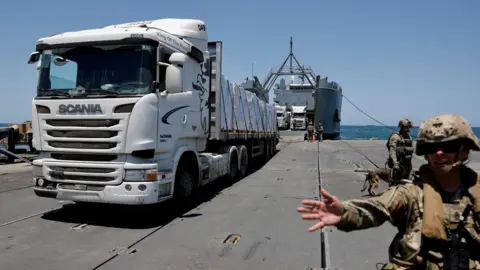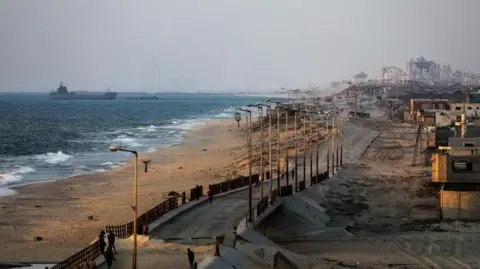ARTICLE AD BOX
21 minutes ago
By Paul Adams, BBC Diplomatic Correspondent

 Reuters
Reuters
The US military was forced to remove the floating pier on 28 June because of bad weather
The US says the floating pier designed to increase the amount of aid getting into the Gaza Strip will “soon cease operations”, less than two months after it was installed.
The announcement came after the US military were unable to re-anchor the pier this week because of “technical and weather-related issues”. It had to be removed on 28 June because of bad weather.
A Pentagon spokesman said more than 8,000 tonnes of humanitarian aid had been delivered from the pier while it was in operation.
He also stressed that it had always been intended as a temporary solution.
US officials suggested it would remain in place until August or September, when changing sea states in the Mediterranean might make it impossible to maintain.
In fact, the weather proved challenging almost as soon after it started operating on 17 May.
For a flagship scheme first announced by President Joe Biden in his State of the Union address in March, the JLOTS (Joint Logistics Over-the-Shore) has had a brief, chequered history.
Following stormy weather in late May, four small landing craft involved in the operation broke loose and were washed ashore.
Days later, parts of the pier were removed and taken to the Israeli port of Ashdod for repairs.
In mid-June, the whole structure, built by US engineers at a cost of $230m (£178m), was taken to Ashdod, again because of the weather.
“Temporarily relocating the pier will prevent structural damage caused by the heightened sea state,” the Pentagon said at the time.
The pier was re-anchored on 19 June, but operations paused again, less than a week later, “for scheduled maintenance activities”.
The scheme was also buffeted by heavy political weather.
When Israeli commandos rescued four hostages from the nearby Nuseirat refugee camp on 8 June, a video showing an Israeli helicopter taking off near the pier triggered speculation on social media that US forces were involved in the rescue.
There was no evidence of American involvement, but the Pentagon was forced to issue a strongly worded denial.
“The temporary pier on the coast of Gaza was put in place for one purpose only,” it said. “To help move additional, urgently needed lifesaving assistance into Gaza.”
America’s role as Israel’s chief military and diplomatic backer meant that the pier was always likely to be the focus of Palestinian suspicions, however unfounded.
“When the pier has worked as intended, it supplied Gaza with much needed aid,” one Gaza-based aid worker said.
“However... its involvement in perceptions of partiality reduced its sustainability.”
For a scheme designed to improve the provision of humanitarian aid, at a time when Israel’s military campaign had left many Gazans on the brink of starvation, what difference did it make?
Joe Biden said the pier would “enable a massive increase in the amount of humanitarian assistance getting into Gaza every day”.

 EPA
EPA
The Pentagon insisted that the pier had always been intended as a temporary solution
At the end of June, US Central Command (Centcom) said more than 8,831 tonnes of aid had been delivered, with more than half of that arriving over the course of the previous week.
But it also announced yet another setback, saying that “due to anticipated adverse weather”, the pier had to be moved back to Ashdod once more.
It was due to be reinstalled this week to deal with a backlog of aid that has accumulated in Cyprus and on a floating dock moored off the Gaza coastline.
But on Thursday, Pentagon spokesman Maj Gen Pat Ryder announced that Centcom personnel were unable to re-anchor the pier to the shore.
“The pier and support vessels and equipment are returning to Ashdod where they will remain until further notice. A re-anchoring date has not been set,” he said.
He added: “As highlighted in the initial deployment announcement, the pier has always been intended as a temporary solution to enable the additional flow of aid into Gaza during a period of dire humanitarian need, with limited access, supplementing land and air channels of delivery."
"The pier will soon cease operations, with more details on that process and timing available in the coming days.”
The total delivered so far represents a tiny fraction of what is needed.
According to the UN, about 500 aid trucks entered Gaza every day before the start of the war between Israel and Hamas last October.
The comparisons are imprecise, but over the course of two months, the US pier has delivered roughly the equivalent of one day’s pre-war aid delivery.
And getting the aid ashore has only been part of the challenge. Delivering it, safely, to the people who need it is extremely hazardous.
With Israeli troops this week mounting a fresh ground operation into nearby Gaza City, ensuring safety for aid workers remains as challenging as ever.
The breakdown of law and order throughout the Gaza Strip as a result of Israel’s relentless targeting of anyone associated with Hamas, including police officers, means that looting - whether organised or opportunistic - is still rife.
Aid that has made it ashore has often remained stuck in the Israeli-controlled marshalling yard, with aid agencies reluctant to collect and distribute it in such an insecure environment.

 6 months ago
25
6 months ago
25








 English (US) ·
English (US) ·